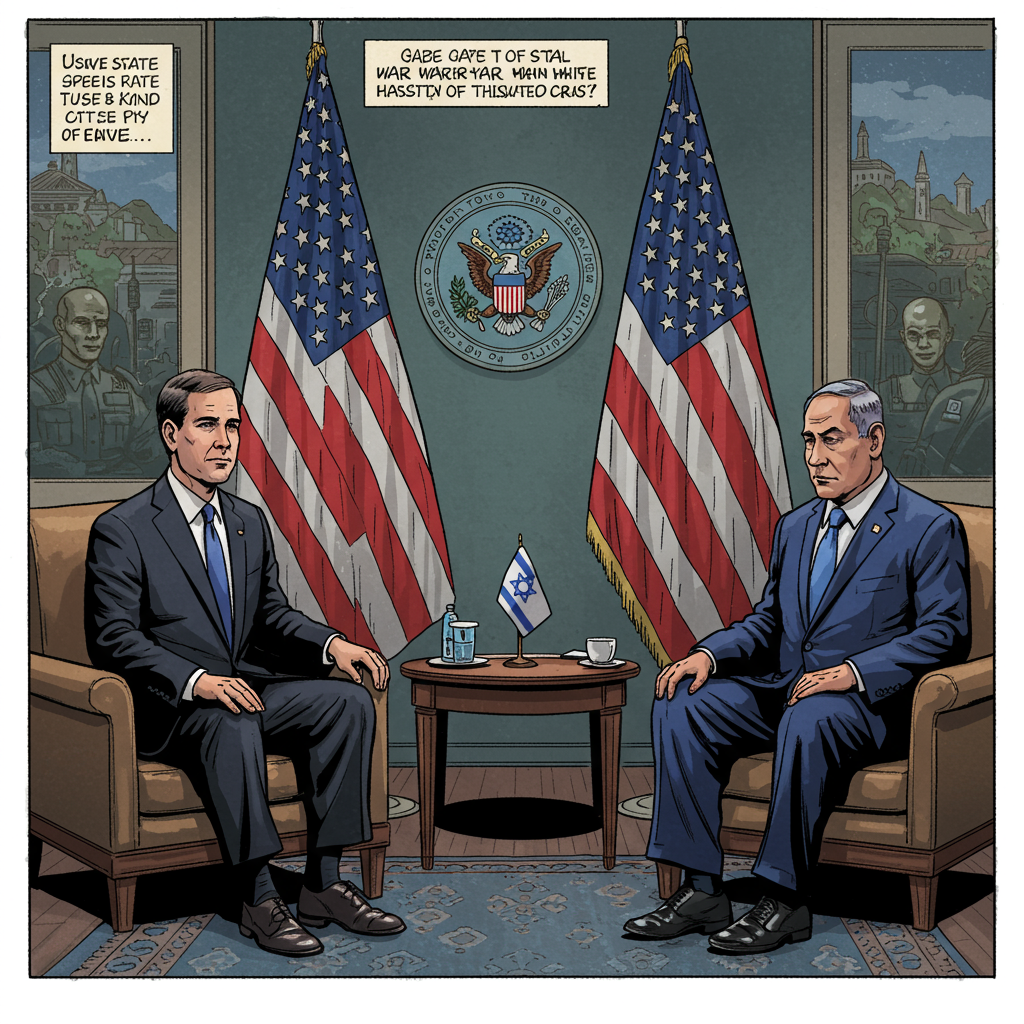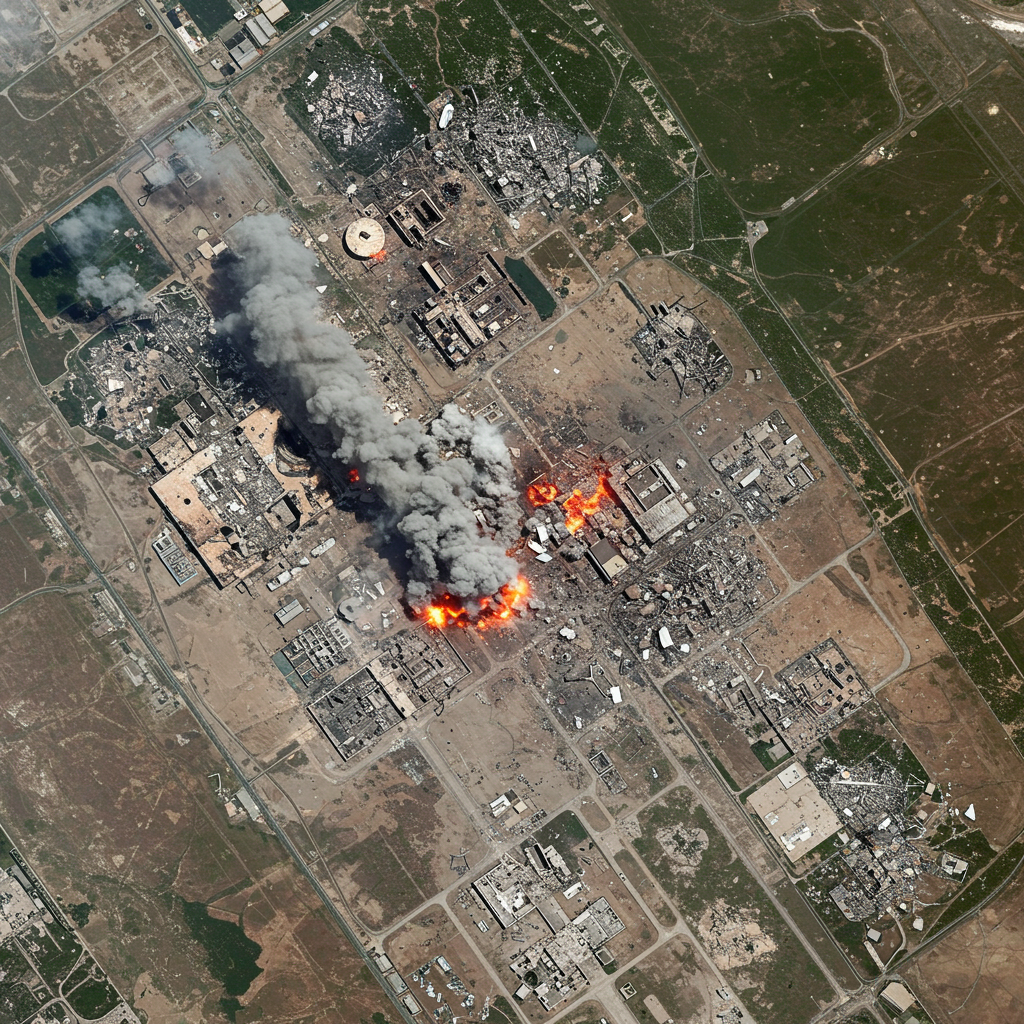U.S. Secretary of State Marco Rubio embarked on a critical diplomatic mission to Israel on September 14, 2025, engaging directly with Prime Minister Benjamin Netanyahu. This high-stakes meeting aimed to address the escalating conflict in Gaza, the urgent need for hostage releases, and the broader intricacies of Middle Eastern security. Against a backdrop of intensified military operations and regional tensions, Rubio’s visit underscored the enduring, albeit complex, American commitment to Israeli security while navigating a delicate path through international concerns regarding humanitarian aid and calls for a ceasefire.
High-Stakes Diplomacy: Secretary Rubio Arrives in Israel
Secretary Rubio’s arrival in Israel signaled a robust push for American priorities amidst the nearly two-year-old Gaza conflict. Ahead of his flight, Rubio articulated his core objectives on social media: “securing the return of hostages, finding ways to make sure humanitarian aid reaches civilians, and addressing the threat posed by Hamas.” He delivered a strong message, stating unequivocally that “Hamas cannot continue to exist if peace in the region is the goal.”
Rubio, accompanied by his wife Jeanette Dousdebes Rubio, was welcomed at Ben Gurion International Airport by U.S. Ambassador to Israel Mike Huckabee and his wife, Janet Huckabee. This initial reception set the stage for a series of intense discussions focusing on the immediate challenges presented by the ongoing war and Israel’s strategic objectives.
Core Discussions: Gaza War, Humanitarian Aid, and Hamas
The centerpiece of the Rubio Netanyahu Israel meeting involved comprehensive discussions on the conduct and future of the Gaza war. A key agenda item was Israel’s planned military operation to seize control of Gaza City, the largest urban center in the Gaza Strip. This operation followed an earlier Israeli directive for Gaza City residents to evacuate, indicating the military’s intent to operate “with great force” within the area.
During his meetings with Prime Minister Netanyahu and other Israeli officials, Secretary Rubio was tasked with conveying America’s priorities for the Israel-Hamas conflict. These priorities included reaffirming unwavering U.S. commitment to Israeli security while simultaneously pressing for mechanisms to ensure the safe delivery of essential humanitarian aid to Gaza’s civilian population. The U.S. stance remained firm on neutralizing the threat posed by Hamas, echoing Rubio’s assertion that the group’s continued existence is incompatible with regional peace.
Navigating a Complex Conflict: U.S. Stance and Regional Fallout
Rubio’s visit occurred at a particularly sensitive juncture, following a highly controversial Israeli strike on Hamas negotiators in Qatar. This incident, reportedly criticized by President Donald Trump as not advancing U.S. or Israeli goals, significantly complicated efforts to broker a ceasefire and secure the release of hostages in Gaza. The U.S. administration found itself walking a “delicate line,” striving to maintain robust ties with Israel while managing anger among key Middle Eastern allies like Qatar, Saudi Arabia, and the United Arab Emirates.
Coinciding with the Rubio Netanyahu Israel meeting, an Arab-Islamic summit was scheduled in Doha, Qatar. This summit aimed to formulate a collective response to the Qatar strike, as Arab nations faced mounting pressure to move beyond mere condemnations. Qatar’s Prime Minister Hamad bin Khalifa Al Thani publicly stated Qatar “reserves the right to respond” to the attack, even as the U.S. reportedly urged continued mediation efforts. This highlights the complex diplomatic landscape surrounding the Gaza conflict.
Reinforcing the U.S.-Israel Alliance Amidst Global Scrutiny
A significant aspect of Rubio’s visit was the symbolic affirmation of the robust American-Israeli alliance. Following a one-on-one meeting, Rubio and Netanyahu, accompanied by their wives and Ambassador Huckabee, visited the Western Wall in Jerusalem. This site, also known as the “Wailing Wall,” holds profound religious significance for the Jewish people. During their visit, Netanyahu revealed they “buried a note among the stones,” a symbolic gesture emphasizing the enduring bond.
Prime Minister Netanyahu used the occasion to underscore the strength of the partnership, describing Rubio’s visit as “a testament to the resilience and strength of the American-Israeli alliance, which is as durable and strong as the stones of the Western Wall that we just touched.” Netanyahu further highlighted the alliance’s strength under President Trump, Secretary Rubio, and their team, expressing deep appreciation on behalf of present-day Israelis and past generations. He and Rubio offered a joint prayer for the safety of the hostages and a special prayer honoring former President Donald Trump, whom Netanyahu lauded as “a true friend of the Jewish people and the State of Israel.”
Opposition to Palestinian State and International Courts
Beyond immediate conflict concerns, the U.S. State Department clarified that Rubio’s discussions would emphasize America’s firm opposition to the “unilateral” recognition of a Palestinian state. This stance reflects a consistent U.S. policy position, contrasting with growing international pressure for a two-state solution.
Furthermore, the U.S. delegation used the visit to criticize the International Criminal Court (ICC) and the International Court of Justice (ICJ), accusing them of engaging in “lawfare” against Israel. This criticism comes in the wake of the ICC issuing arrest warrants for Israeli leaders, including Prime Minister Benjamin Netanyahu, on charges related to alleged war crimes in Gaza. The ICJ is also currently hearing South Africa’s genocide case against Israel, having already issued provisional measures to protect Palestinian civilians. Rubio also met with families of Israeli citizens held captive by Hamas, reinforcing the humanitarian dimension of the U.S. diplomatic efforts.
Humanitarian Concerns and Civilian Impact
The ongoing conflict has deeply impacted civilian populations, particularly within the Gaza Strip. Israel’s evacuation order for Gaza City residents, preceding an intensive military operation, raised significant humanitarian concerns regarding the safety and displacement of civilians. The destination and welfare of these displaced Palestinians remained a critical issue.
In parallel, a report from the Palestinian Prisoners’ Society documented numerous arrests by Israeli forces in the occupied West Bank and East Jerusalem. During August alone, 540 arrests were carried out, including children and women, bringing the total number of Palestinians arrested in these areas to over 19,000 since the war’s commencement. Conditions in some Israeli detention facilities, such as the “Rakevet” section of Ramleh Prison, have drawn severe criticism, with detainees from Gaza reporting “torture, abuse, starvation and terror” at the hands of Israeli guards. Critics draw parallels between these detentions and the Israeli hostages held by Hamas, highlighting a cycle of suffering.
Hamas, in turn, condemned an Israeli operation that reportedly involved arresting academics, including female university students, labeling these actions as “systematic terrorism.” Hamas urged human rights organizations to document such incidents for submission to international courts. Further exacerbating the humanitarian crisis, a Palestinian youth news agency reported that Israeli warplanes bombed a building at the Islamic University in Gaza, resulting in civilian fatalities and injuries among those sheltering inside.
The Contested City of David and Broader Geopolitical Implications
Rubio’s itinerary in Israel also included a visit to the City of David, an archaeological site and tourist destination within the Palestinian neighborhood of Silwan in contested East Jerusalem. This site, containing some of the oldest remains of the 3,000-year-old city, has been a source of controversy. Accusations persist that its operators promote a nationalistic agenda that undermines Palestinian residents and their claims to the area.
This visit highlights the deep-seated complexities surrounding East Jerusalem. Israel captured and annexed the area in the 1967 Mideast war, asserting the entire city as its undivided capital. Palestinians, however, envision East Jerusalem as the capital of a future state encompassing the West Bank and Gaza Strip, making its status a central point of contention in the Israeli-Palestinian conflict and a crucial element in any prospective peace deal.
Frequently Asked Questions
What were Secretary Rubio’s main objectives for his diplomatic visit to Israel?
Secretary Rubio’s primary objectives for the Rubio Netanyahu Israel meeting were multifaceted. He aimed to secure the release of all hostages held by Hamas, ensure the delivery of essential humanitarian aid to civilians in Gaza, and address the persistent threat posed by Hamas, emphasizing that the group’s continued existence is incompatible with regional peace. He also sought to convey America’s broader priorities in the Israel-Hamas conflict and reaffirm the U.S. commitment to Israeli security amidst ongoing military operations and regional tensions.
Where did Secretary Rubio and Prime Minister Netanyahu meet in Jerusalem during the visit?
Following their initial one-on-one meeting, Secretary Rubio and Prime Minister Netanyahu, accompanied by their wives and Ambassador Huckabee, visited the Western Wall in Jerusalem. This deeply significant religious site for the Jewish people served as a backdrop for symbolic gestures of alliance strength, including burying a note among the stones and offering joint prayers. Rubio also visited the City of David, an archaeological site in contested East Jerusalem, during his itinerary.
How did the U.S. balance its support for Israel with concerns over the controversial Qatar strike?
The U.S. navigated a “delicate line” after Israel’s controversial strike on Hamas negotiators in Qatar. While Secretary Rubio’s visit was a clear show of unwavering U.S. support for Israel, President Trump had expressed unhappiness with the Qatar strike, stating it “does not advance Israel or America’s goals.” The U.S. also joined a U.N. Security Council statement condemning the strike without explicitly naming Israel. This approach aimed to maintain strong relations with Israel while managing anger among key Middle Eastern allies, including Qatar, whose mediation efforts were crucial for hostage release and ceasefire negotiations.
Conclusion: A Diplomatic Tightrope Walk
Secretary Rubio’s high-profile visit to Israel served as a critical juncture in U.S. foreign policy regarding the Middle East. The Rubio Netanyahu Israel meeting underscored the Biden administration’s unwavering support for Israel’s security, even as it grappled with complex humanitarian crises and the broader geopolitical fallout of the Gaza conflict. Discussions around the Gaza City operation, the fate of hostages, and the delivery of humanitarian aid highlighted the immediate pressures on both nations.
Simultaneously, the U.S. navigated regional sensitivities, particularly following the controversial Qatar strike, and reaffirmed its stance against a unilateral Palestinian state and perceived “lawfare” by international courts. As the conflict continues, the diplomatic tightrope walk demonstrated by Secretary Rubio’s visit reflects the intricate balance required to address immediate security concerns, humanitarian imperatives, and the long-term prospects for stability in a deeply fractured region.


